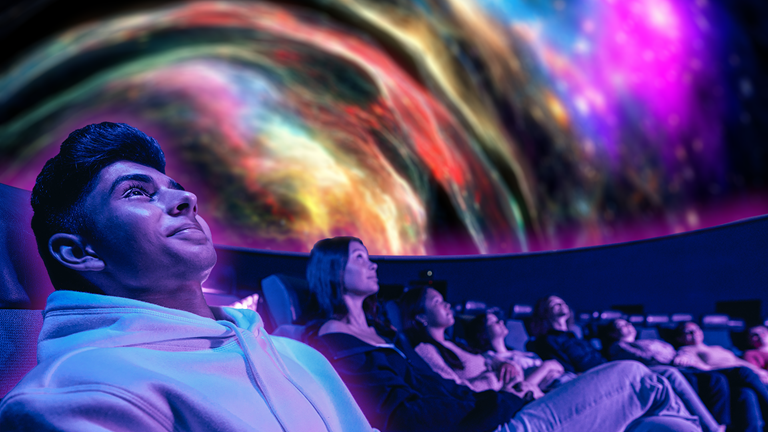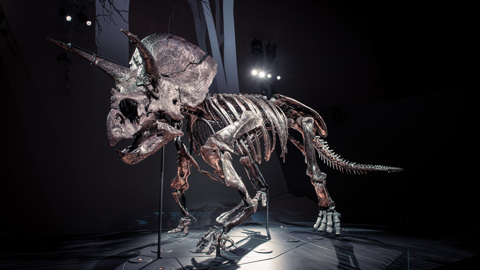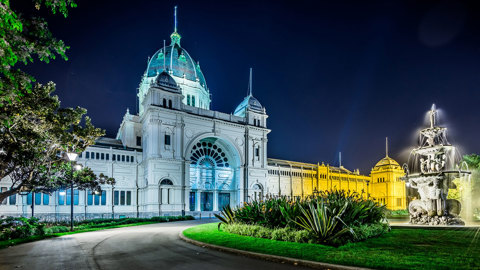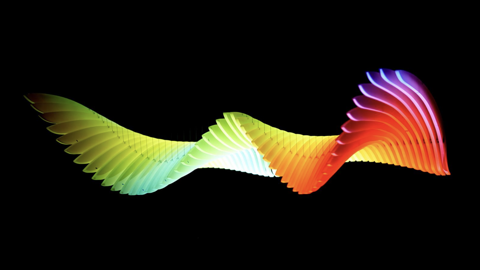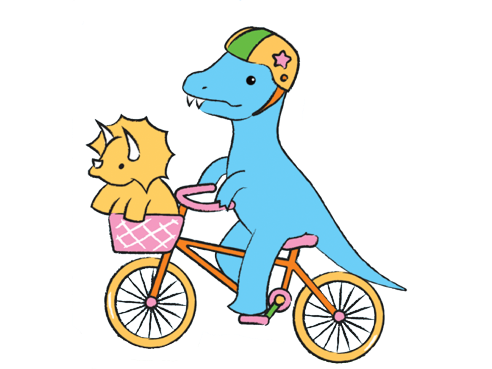Skynotes: September 2025
Upcoming events
New camera, new astronomy
Researchers at the Indian Institute of Science have developed an ‘eye-like’ or neuromorphic camera better able to detect fainter or faster-moving objects than conventional charged couple devices or CCD cameras. Experimental results include: the faint star Sirius B seen alongside its far brighter companion Sirius A; a high velocity meteorite passing near the bright Moon; and small moons orbiting Saturn and its bright rings.
Standard cameras can mask bright objects to reveal faint light sources but they struggle with over-saturation, and stacking different exposure times to produce a composite image has its limits. Conventional CCD cameras are also poor at seeing fast moving objects which produce unwanted motion blurring.
The new camera side-steps these issues by using much higher frame rates to sample incoming photons and, crucially, detects them by using a logarithmic rather than a traditional linear scale. It can detect very bright and very faint objects simultaneously. The camera’s pixel response to incoming light can be set to a specific threshold to avoid ‘over exposure’. As researchers claim, the new camera is “inspired by the human retina… preserving details across a wide range of luminosities”. It also uses far less power, an asset in space probes or space telescopes where there are typically tight constraints on power.
The new low-power camera offers potential in fields outside of astronomy for observing faint or fast-moving objects in circumstances of varying light intensity.
Explore:
- Enhancing Celestial Imaging (Indian Institute of Science) also at iScience Notes (Indian Institute of Science)
- Cameras that work like our eyes… (Matthew Sparkes, New Scientist)
- Neuromorphic Vision (Indian Institute of Science)
Spring Equinox
Here in the southern hemisphere we are about to experience Spring Equinox (or Vernal Equinox from the Latin ver for spring-time, a period of new growth). This is when day and night are effectively the same length. This will occur on Tuesday 23rd and marks the end of winter and beginning of spring in the southern hemisphere, and the transition from summer to autumn in the northern hemisphere.
At the equator at an equinox the noon sun sits directly overhead and both hemispheres receive equal hours of daylight. However, away from the equator the sun’s path in the sky is midway between its high long summer arc and its low short winter one.
The main reason for the seasons lies in our planet’s titled axis of rotation which is 23.5 degrees with respect to its orbit around the sun. At an equinox neither hemisphere leans toward or away from the sun.
However, local day and night are not exactly equal at an equinox. Astronomical timings are based on how long the centre point of the Sun’s disc is above the horizon. A local day effectively starts when the ‘leading edge’ or limb of the Sun broaches the eastern horizon and ends when its ‘tailing edge’ or limb drops below the western horizon.
There is also a terrestrial effect as well. The Earth’s atmosphere refracts or bends light from the Sun so that at sunrise we get the first glimpse of the Sun before it physically crosses the local horizon. The reverse occurs at sunset when we see the Sun for a few minutes after it has already sunk below the western horizon.
Explore:
Melbourne Sun times
| Date | Rise | Set | Day length | Solar noon* |
|---|---|---|---|---|
| Monday 1st | 6:42am | 5:58pm | 11:16hours | 12:20pm |
| Thursday 11th | 6:27am | 6:07pm | 11:40hours | 12:16pm |
| Sunday 21st | 6:11am | 6:15pm | 12:04hours | 12:12pm |
| Tuesday 30th | 5:57am | 6:23pm | 12:25hours | 12:10pm |
*When the sun is at its highest, crossing the meridian or local longitude.
Moon phases
| Phase | Date |
|---|---|
| Full Moon | Monday 8th |
| Third Quarter | Sunday 14th |
| New Moon | Monday 22nd |
| First Quarter | Tuesday 30th |
See:
Your Moon Guide for September 2025
Moon distances
Lunar apogee (furthest from Earth) is on Friday 26th at 405,548 km.
Lunar perigee (closest to Earth) is on Friday 26th at 364,777 km.
Planets
Mercury is soon to pass behind the Sun and is not visible this month.
Venus is just still visible in the east from 5am before fading by dawn’s early light.
Mars is soon to move behind the Sun for its solar conjunction but will remain visible this month from 6:50pm in the west until its sets by 8pm.
Jupiter has now passed behind the Sun and can now be seen rising in the east around 3:30am before fading in the north-east by dawn. It will be visible a little earlier each morning during the month.
Saturn is nearing opposition and can be seen rising in the east at 8pm and traversing the north until being lost from view in the west by dawn. Like Jupiter, it will appear a little earlier each evening.
Meteors
While not a good time for meteors this month the Southern Piscids will peak from 11th to the 20th. They usually number only a few per hour and appear in the constellation of Pisces, the fish, which rises in the north-west from midnight. Find out more about these space visitors at NASA Asteroids, Comets and Meteors
Stars and constellations
In the north
High in the north is Sagittarius (the archer centaur) with its bow and arrow forming the famous asterism The Teapot, the spout of which leads across the zenith to the curving tail of nearby Scorpius. Lower in the north sits Aquila (the eagle) with Altair or Alpha Aquilae, the 12th brightest star at night. And quite low in the north is Lyre (the lyre) and its principal star Vega or Alpha Lyrae which is the 5th brightest star at night.
In the east
Directly east this month is a trio of adjacent constellations. In the centre is Aquarius, the water bearer while above is Capricornus (the goat), and to its left sits Pisces Austrinus (Southern Fish) with its principal star Formalhaut (Alpha Piscis Austrinus).
In the south
Low in the south-west can easily be seen two of the brightest stars in the night sky, Alpha and Beta Centauri. These are the two brightest stars in the constellation of Centaurus (the centaur) with Alpha Centauri also known as Rigel Kentaurus (foot of the centaur). Together these two stars are referred to as The Pointers as they lead directly to the unmistakable diamond shape of Crux or Southern Cross. Crux is the smallest of the traditional 88 constellations astronomer use and is an easy feature of the night sky to observe, even in city surroundings.
In the south-east is the 10th brightest star Achernar in the long constellation Eridanis (the river) that winds its way down to the horizon.
In the west
High in the west sits the curving tail, body and pincers of the scorpion, Scorpius. Within its body you should see red giant star Antares which will appear more orange than red in light polluted skies. In front of the Scorpion’s wide head and closer to the horizon sits Libra (the scales).
International Space Station
At a distance of about 400km the ISS completes an orbit every 90 minutes and appears as a bright object that moves slowly across the night sky. There will be many visible passes this month over Melbourne and Central Victoria. Here are some of the brightest and highest in elevation this month:
Morning
Tuesday 16th 5:20am-5:27am North-West to East-South-East
Thursday 18th 5:20am-5:26am West-North-West to South-East
Friday 19th 4:33am-4:37am South-South-East to South-East
Heavens Above gives predictions for visible passes of space stations and major satellites, live sky views and 3D visualisations. Be sure to first enter your location under ‘Configuration’.
On this day
1st 1939, Americans J Robert Oppenheimer and Hartland Snyder publish the first paper that describes the gravitational contraction of a star which later led to the modern concept of black holes.
1st 1859, Carrington Event, most powerful geomagnetic storm ever recorded. Now understood as a Coronal Mass Ejection (CME) from the Sun that hit Earth’s magnetosphere inducing strong northern auroras almost to the equator, and telegraph interference in Europe and North America with operators receiving electric shocks, poles sparking, and signals sent despite power cut off.
1st 1979, Pioneer 11 (USA) made the first flyby of Saturn returning the first close-up images of the planet. It was the second probe to pass the asteroid belt and Jupiter and to reach solar escape velocity. Last routine contact was on 30 September 1995 and final data received was on November 1995.
5th 1977, Voyager 1 (USA) is launched to explore the outer Solar System. After 42 years it continues sending data and is the most distant probe at 21.8 billion km (146 AU). It entered interstellar space in 2012 and its power supply may last until 2025.
8th 2004, Genesis (USA) probe crashes in Utah while returning samples of solar wind particles. Some collecting panels survived impact and were recovered giving successful scientific results.
11th 1985, the International Cometary Explorer or ICE (USA) became the first spacecraft to encounter a comet by flying through the dust tail of Comet Giacobini-Zinner.
14th 1959, Luna 2 (USSR) was the first craft to fly to and impact another body, in this case the Moon. It released sodium gas to allow visible tracking, used radio for telemetry transmission, and crashed into Mare Imbrium (the Sea of Rains).
17th 1976, NASA unveils its concept for a Space Transportation System, a rocket launched and glider return orbiter known as the Space Shuttle.
17th 1857, birth of Konstantin Tsiolkovsky, a pioneering Russian then Soviet teacher whose theoretical work on aerodynamics and rocketry influenced all who followed. He advocated spaceflight and believed humans would colonise the galaxy.
18th 1977, Voyager 1 (USA) sends the first image of Earth and Moon together taken, from a distance of 11.6 million km while on its way to Jupiter.
21st 1633, the Roman Catholic Inquisition begins its trial of Galileo for heresy in publishing and advocating a heliocentric or Sun-centred solar system contrary to church doctrine, dogma and scripture.
23rd 1846, Neptune, first predicted by Urbain Le Verrier (France), is discovered by Johanne Gottfried Galle (Germany) with John Couch Adams (UK) recognised for an independent discovery.
27th 1905, Albert Einstein published his paper containing the famous equation E=mc2 (energy equals mass multiplied by the speed of light squared), meaning a small amount of matter is equivalent to, or can be converted into, a great deal of energy.



